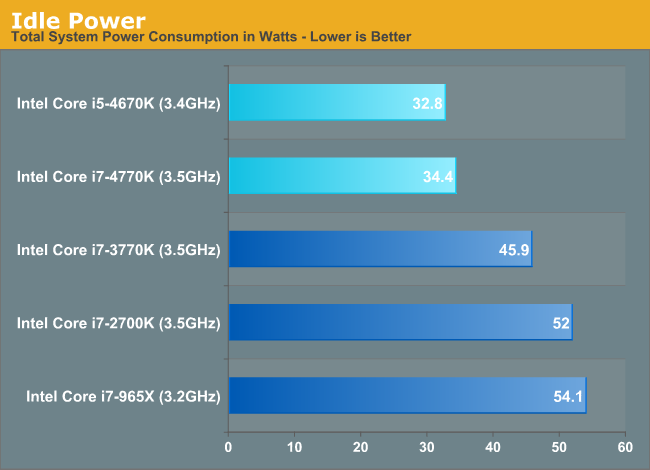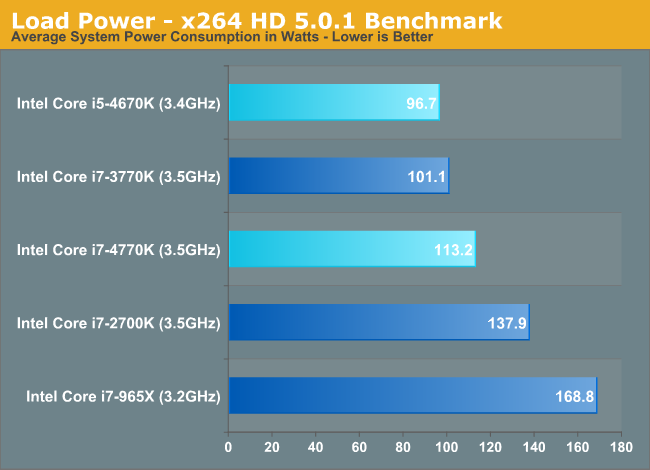The Haswell Review: Intel Core i7-4770K & i5-4670K Tested
by Anand Lal Shimpi on June 1, 2013 10:00 AM ESTPower Improvements
Although Haswell’s platform power is expected to drop considerably in mobile, particularly with Haswell U and Y SKUs (Ultrabooks and ultrathins/tablets), there are benefits to desktop Haswell parts as well.
There’s more fine grained power gating, lower chipset power and the CPU cores can transition between power states about 25% quicker than in Ivy Bridge - allowing the power control unit to be more aggressive in selecting lower power modes. We’ve also seen considerable improvements on lowering platform power consumption at the motherboard level as well. Using ASUS’ Z77 Deluxe and Z87 Deluxe motherboards for the Haswell, Ivy and Sandy Bridge CPUs, I measured significant improvements in idle power consumption:

These savings are beyond what I’d expect from Haswell alone. Intel isn’t the only one looking to make things as best as can be in the absence of any low hanging fruit. The motherboard makers are aggressively polishing their designs in order to grow their marketshare in a very difficult environment.
Under load, there’s no escaping the fact that Haswell can burn more power in pursuit of higher performance:

Here I’m showing an 11.8% increase in power consumption, and in this particular test the Core i7-4770K is 13% faster than the i7-3770K. Power consumption goes up, but so does performance per watt.
The other big part of the Haswell power story is what Intel is calling FIVR: Haswell’s Fully Integrated Voltage Regulator. Through a combination of on-die and on-package circuitry (mostly inductors on-package), Haswell assumes responsibility of distributing voltages to individual blocks and controllers (e.g. PCIe controller, memory controller, processor graphics, etc...). With FIVR, it’s easy to implement tons of voltage rails - which is why Intel doubled the number of internal voltage rails. With more independent voltage rails, there’s more fine grained control over the power delivered to various blocks of Haswell.
Thanks to a relatively high input voltage (on the order of 1.8V), it’s possible to generate quite a bit of current on-package and efficiently distribute power to all areas of the chip. Voltage ramps are 5 - 10x quicker with FIVR than with a traditional on-board voltage regulator implementation.
In order to ensure broad compatibility with memory types, there’s a second input voltage for DRAM as well.
FIVR also comes with a reduction in board area and component cost. I don’t suppose this is going to be a huge deal for desktops (admittedly the space and cost savings are basically non-existent), but it’ll mean a lot for mobile.
No S0ix for Desktop
You’ll notice that I didn’t mention any of the aggressive platform power optimizations in my sections on Haswell power management, that’s because they pretty much don’t apply here. The new active idle (S0ix) states are not supported by any of the desktop SKUs. It’s only the forthcoming Y and U series parts that support S0ix.










210 Comments
View All Comments
IUU - Thursday, June 6, 2013 - link
These are some very good processors. What is misplaced though is the graphics part. It is ok for mobile processors to have such a part, but for high energy consuming desktop processors, it is irrelevant and more of a burden. In the desktop world you expect a cpu with the highest possible processing power. It is 2013 and quad core is kind of old, come on intel don't be shy bring 8 and 10 core processors, you have the room to accommodate it. If I want graphics I 'll buy a monster graphics chip and will not be bothered by "optimal" power consumption.It is sad to see the energy efficiency and the computing efficiency improving only to accommodate a miserable graphics card. If you want us to buy graphics together with the cpu(an apu) make a chip with a tdp 300-400 because this is a mainstream energy budget for the desktop.
If it is impractical(which is probably the case) build your own discrete graphics.
Don't vandalize your cpus this way. If you want the mobile go for it, just don't contaminate your desktop products.
desky - Saturday, June 8, 2013 - link
same with me!I'm currently running an E8400@4,5GHz since 2008, and now seems a good time to upgrade.
I hope the haswell chip will overclock just as good. From what I've read that means that I may have to exchange the thermal paste under the IHS for some coolaboratory stuff...
Not decided on i5 or i7 yet though...
cmdrdredd - Monday, June 3, 2013 - link
You shouldn't have expected a reason to upgrade yet. Sheesh...we knew it would not be a real upgrade over an SB or IB CPU.peckiro - Monday, June 3, 2013 - link
I built a new from the case up Z77 rig with a 3570K processor running 24/7 @ 4.4GHz last fall. I seriously considered waiting for Haswell to hit the market before upgrading my machine (circa 2007). I'm glad I didn't wait any longer since, I have been running a damned fast machine for 8 months now. I think I may have felt perhaps a little bit underwhelmed if I had waited for Haswell. Just my 2 cents worth.cmdrdredd - Monday, June 3, 2013 - link
Yep...I built up my current 3570k system around the summer last yearyearkaiserreich - Saturday, June 1, 2013 - link
While you are right that load power consumption is higher, the system is not loaded all the time.Not for the common users any way. In that case, idle will serve as a better power performance indicator as opposed to load consumption.
tential - Saturday, June 1, 2013 - link
Pulling up this website and browsing my CPU utilization is under 20% and under 10-5% the majority of the time. Now I'm 5 years back on a Core2Duo. I'd imagine by now, if I was browsing this page on a Haswell, it'd be even lower considering processors are much faster as well. So mobile side I'm guessing that average battery life increased quite a bit. We'll see with the review. Using LOAD power consumption to judge mobile though is just plain ignorant.This is why some people need to stick to reading reviews, and wait for full reviews come out, rather than jumping to early conclusions and misinterpreting information.
t.s - Sunday, June 2, 2013 - link
So, what about people that want to gaming on laptop?takeship - Sunday, June 2, 2013 - link
Did you realize that these are all desktop chips? Let's not judge using desktop parts. But seriously, what percentage of users game with a mobile quad core & intel graphics?krumme - Saturday, June 1, 2013 - link
5-10% is on the positive side imho.http://www.guru3d.com/articles_pages/core_i7_4770k...
Sometimes it can even be slower :)
This processor is not intented for desktop. There is nothing wrong in that. But why all this bs covering it. Its a fine processor and a weird and shallow review.